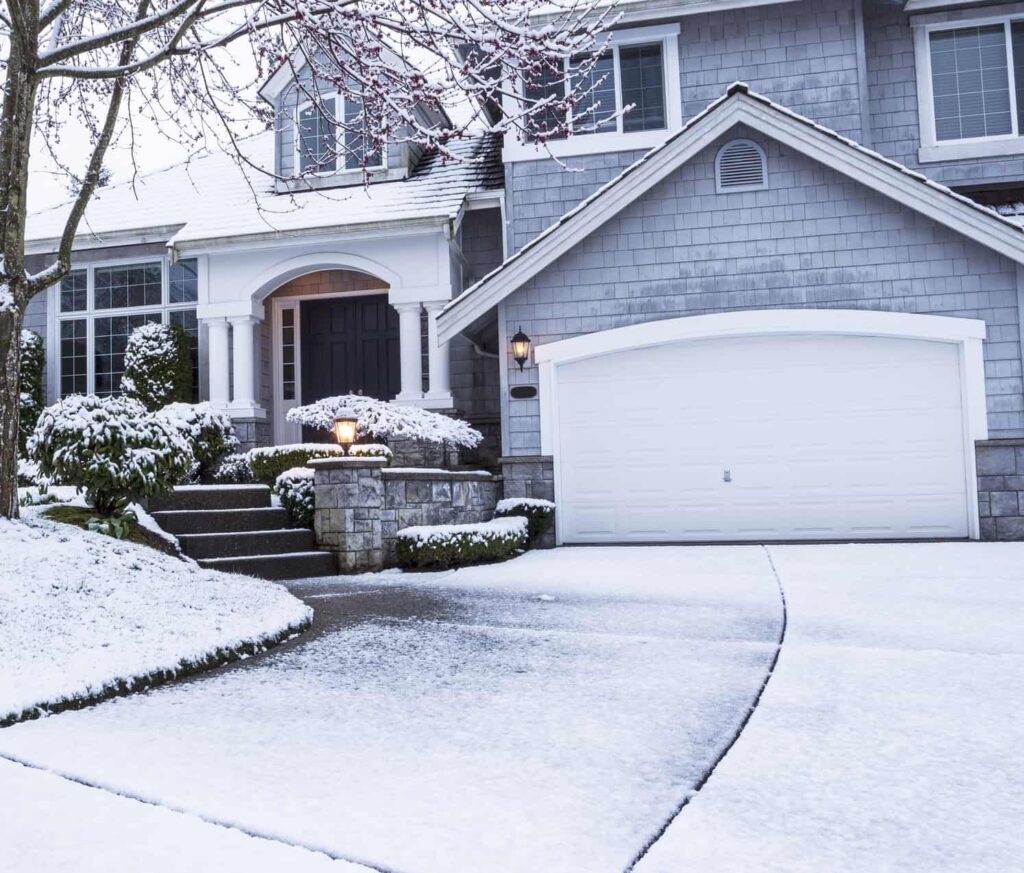
When winter hits with its icy grip, it’s not just the trees, roads, and rooftops that bear the brunt – your concrete driveway also takes a winter beating. The cycle of freezing and thawing, the harsh salts used to de-ice roads, and the heavy weight of snow removal equipment can all contribute to the wear and tear of your concrete driveway. Understanding the impact of these winter elements on your driveway is the first step towards implementing effective cold-weather maintenance strategies, helping you prevent costly repairs and preserve your driveway’s appearance and longevity.


Freezing and Thawing Cycle
Winter’s freezing and thawing cycle can cause significant damage to concrete driveways. When water infiltrates the porous material of concrete, it expands upon freezing, leading to internal pressure that can cause cracking, chipping, or flaking. This is known as frost heaving. The repetitive nature of freeze-thaw cycles throughout winter can exacerbate this damage, eventually leading to structural deterioration of the driveway.

photo of suburban home with snow on drive way, lawn, plants, trees and roof
Chemical Damage from De-icing Salts
De-icing salts are commonly used in winter to melt ice on driveways, but these can cause chemical damage to the concrete. These salts, primarily composed of calcium or sodium chloride, can penetrate into the concrete and corrode the steel reinforcements within. Additionally, the salts can amplify freeze-thaw stress by increasing the number of freezing and thawing cycles. Long-term use of de-icing salts can lead to a condition called “salt scaling”, where the surface of the concrete peels away, leaving it rough and pitted.
PRE-WINTER PREPARATION FOR YOUR CONCRETE DRIVEWAY
To effectively safeguard your concrete driveway from winter damage, it’s crucial to undertake preventative measures before the cold weather sets in. Pre-winter preparation involves inspecting your driveway for any existing cracks and repairing them promptly to prevent water intrusion.
Applying a high-quality concrete sealer can provide a protective layer, minimizing the penetration of water and de-icing salts. Adequate drainage is another key factor to consider, ensuring that water doesn’t pool on the driveway surface and freeze. By taking these preemptive steps, you can enhance the durability and appearance of your driveway throughout the winter months.
Inspect and Repair Existing Cracks
Before winter sets in, closely examine your concrete driveway for any signs of cracking. Even small, seemingly inconsequential cracks can become a gateway for water infiltration, which can lead to significant damage during the freeze-thaw cycles of winter. To repair these cracks, clean them thoroughly to remove any debris, then fill them with a high-quality concrete crack filler. Be sure to follow the manufacturer’s instructions to ensure effective repair. This step is crucial in preventing water from seeping into the driveway, freezing, and causing further damage.
Applying Sealant for Extra Protection
Applying a quality sealant to the surface of your driveway is another vital step in pre-winter preparation. A sealant acts like a protective coat on the surface of the concrete, creating a barrier that prevents water, de-icing salts, and other harmful substances from penetrating into the concrete. This protective layer can help reduce the risk of frost heaving and salt scaling, preserving the structural integrity and appearance of your driveway. It’s recommended to apply the sealant in dry, mild weather for optimal absorption and effectiveness. Always consult with the sealant manufacturer’s instructions to ensure proper application.
WINTER MAINTENANCE TIPS FOR CONCRETE DRIVEWAYS
Proper Snow Removal Techniques
One crucial element of winter maintenance for concrete driveways is using proper snow removal techniques. It’s important to remove snow promptly to prevent it from melting and seeping into the concrete, which can lead to the damaging freeze-thaw cycle. However, it’s essential to avoid using metal shovels or snow blowers that can scrape or chip the driveway surface. Instead, use plastic shovels or a snow blower with a rubberized bottom to gently remove snow without damaging the concrete. Additionally, avoid aggressively chipping ice off the driveway as it can cause surface damage or even cracks. Instead, use a safe ice melting product that doesn’t contain harmful salts. Regular and careful snow removal can go a long way in preserving your driveway’s condition throughout winter.
Safe and Effective De-icing Methods
When it comes to de-icing, not all methods are created equal. Certain de-icing materials can cause damage to your concrete driveway, while others are safe to use. Here are a few safe and effective de-icing methods:
Remember, whichever method you choose, it’s crucial to use these products sparingly and only when necessary. Overuse can lead to unnecessary damage and can be harmful to the surrounding environment.
Regular Cleaning and Maintenance
Maintaining the cleanliness of your driveway throughout the winter season is another integral part of upkeep. Regular cleaning prevents the accumulation of dirt, debris, and chemicals that can cause damage over time.
PROFESSIONAL SERVICES FOR WINTER-PROOF DRIVEWAY
While DIY methods can be effective in maintaining your concrete driveway during winter, there are also considerable benefits to opting for professional services.
When selecting a reliable service provider for winter-proofing your driveway, it’s important to consider a few key factors. First, check the provider’s experience and reputation in the field – credible providers such as JC Masonry & Concrete Design have a proven track record of delivering high-quality services. Read through customer reviews and testimonials to gauge their reliability and quality of work.
Second, ensure they offer the specific services you need, from pre-winter preparation to post-winter restoration. Third, ask about the products they use to ensure they are high quality and suitable for your specific driveway. Lastly, obtain a clear quotation for the services to avoid any unexpected costs. By taking these steps, you can find a service provider who will ensure your driveway withstands the harsh winter months and maintains its quality and appearance year-round.
In conclusion, winter-proofing your concrete driveway is a multi-step process that requires careful planning, timely action, and regular maintenance. By understanding the impact of winter on your driveway and implementing proactive measures such as repairing cracks, applying sealant, and using safe de-icing methods, you can minimize the damaging effects of cold weather.
Regular cleaning and maintenance, along with the use of professional services, can further enhance your driveway’s durability and longevity. While winter may pose challenges, these strategies will help you ensure your concrete driveway remains in excellent condition all year round.
Other Articles

How to Choose the Right Concrete Contractor for Your Home

Top 10 Benefits of Hiring Professional Masonry Contractors

Why Long Island Homeowners Trust Local Masonry Contractors for Their Renovations
Add Your Heading Text Here
Do You Have
Any Inquiries?
For exceptional masonry and concrete services, contact JC Prestige Projects to get started today.